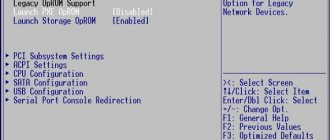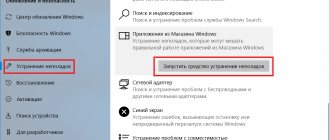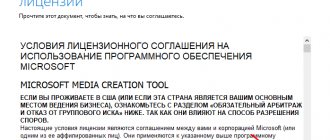Windows 10 is positioned by the developer as a modern, convenient and productive operating system, which includes a basic set of all necessary components and programs. Installed out of the box, Windows 10 is completely ready to use, however, many will probably want to change its default settings in order to gain more control and performance. In this guide, we will look at such an important and interesting topic as setting up Windows 10 after installation. From 16 practical tips you will learn which options it is advisable to enable and disable in a newly installed system, making working with the OS even more convenient and practical.
Checking and installing missing drivers
Windows 10 contains the necessary drivers for most devices; if the system and software are working normally, you don’t need to do anything. However, if you have unknown devices or devices marked with a yellow icon Device Manager Beginner users are recommended to use special programs for this, for example, Driverpack Solution . The missing drivers may be on the optical disc supplied with the computer (usually a laptop). Otherwise, you will have to look for drivers on the Internet.
Alt+Tab
The Windows 10 Preview Build update also changes how Alt-Tab works, allowing users to quickly switch between open Windows and Microsoft Edge tabs.
Each Microsoft Edge tab will appear separately on the Alt-Tab app switcher screen. If you have multiple tabs open, you can switch between tabs and applications using the Alt+Tab keyboard shortcut.
Microsoft says it has included an option to disable the new Alt-Tab interface for those who have many tabs open.
Finding and installing system updates
Immediately after installing Windows 10, it is advisable to check for cumulative updates, especially if you plan to regularly update the operating system.
Step 1 . Go through “ Settings ” to the “ Update and Security ” section and click the “ Check for updates ” button.
Step 2 . Install packages from the same interface, if any are found.
How do the representatives themselves answer this pressing question?
The head of the department of innovative projects at Microsoft, Jerry Nixon, said that after Windows 10 there will definitely not be subsequent versions of the OS.
After Win 10, the company's programmers will begin to develop a completely different operating system. According to D. Nixon, Microsoft has not yet approved the new name of the operating system, but it will be a full-fledged replacement for Windows, according to a BBC source.
The corporation’s specialists deliberately omitted the number “Nine” for use in the name of the new system, and immediately assigned the name “Windows 10,” thereby focusing on the “break with the past.” Before this, new operating systems appeared to replace each other at intervals of approximately three years.
By developing the “lifecycle fact sheet”, Microsoft has already given an answer to the burning question in practice. For a specific user of the “Tenth” OS, there is no difference whether it will be called services or something else. It is important that the 10th operating system, by analogy with old operating systems, will have a certain period of its life cycle. This means that there will also be a time period during which the OS is supported and at this time “upgrades” will be free.
Disable automatic updates
If, on the contrary, for one reason or another you do not want to update, disable Windows Update. This can be done after the initial OS update. It must be said right away that the method proposed here is a temporary solution, since Microsoft is constantly working to limit those user rights that relate to the operation of the update component.
Step 1 . the services.msc command in the Win + R , open the Windows 10 services snap-in and find the “ Windows Update ” service in the list (usually it is located at the bottom of the list) and double-click on it.
Step 2 . Set its startup type to “ Disabled ” and immediately stop it by pressing the corresponding button.
Step 3 . As an additional measure, switch in the current window to the “ Login ” tab, activate the “ Log in with account ” radio button. In the account field, insert .\Guest , delete the password and save the settings. This will restrict the rights of the update component.
Want to know more? We have detailed instructions on how to disable automatic Windows 10 updates in various ways.
The new OS replaced Windows 10
Windows 01/29/2019 | 0
Back in the summer of 2020, the Windows 10 operating system was released, for which five major updates have since been released, as well as several hundred small ones that correct various bugs and shortcomings. The share of computers running this software is gradually growing, but this is happening much slower than Microsoft initially planned. That is why, after almost 3.5 years since the release of the OS, the corporation’s management no longer places high hopes on it.
The management team at Microsoft is well aware that the Windows 10 operating system will not be as popular as Windows 7 once was when it was relevant. The main reason is that many users do not like the symbiosis of the Windows version for computers and tablets with touch screens. Because of this feature, all users have to endure inconvenience to one degree or another, and very few people are happy about this. However, a new OS will be released very soon, which may well be announced in May of this year.
The developers were able to find in the latest builds of Windows 10 a mention of a new operating system called “Product Lite,” although such a designation had never been used before. Soon after this discovery, information appeared that this was exactly the same modular OS that Microsoft employees talked about several years ago. At the same time, sources assure that the latest software will not be included in the Windows line, which the developers will put an end to, ending its history.
The main advantage of a modular OS is that it will allow you to configure the operating system depending on the specific electronic device. So, for example, if a computer does not have a touch screen, it does not need such an interface and a bunch of unnecessary code responsible for its operation. The latest software can work on any electronic gadget, from smartphones to even televisions, if manufacturers of such devices want to use it. At the same time, the new system works with PWA and UWP applications, while there is no support for those created for regular Windows yet, but it may appear in the future.
According to some reports, the new OS will replace Windows 10 as early as 2020, that is, in about a year and a half, although its test build for everyone could be released in the summer or fall of this year. Previously, information was published on how to get a real license for Windows 10 Pro for only 300 rubles.
Attention! Until July 26, everyone can receive a Xiaomi Mi Band 5 sports bracelet for free, spending only 2 minutes on it.
Join us on Google News , Twitter, Facebook, VKontakte, YouTube and RSS to stay up to date with the latest news from the world of future technologies.
AKKet.com Telegram channel
Receive notifications about new materials directly in the messenger - on iOS, Windows, Android and Linux.
MicrosoftWindows 10ComputersTabletsSystems
Removing unnecessary applications
Windows 10 comes with a bunch of built-in universal apps, many of which you probably won't use. If so, it is better to remove them.
Step 1 . Open Settings application Start and go to the Apps and Features .
Step 2 . Here you will see a list of applications built into the system. Click the icon of the program you want to remove, and then click the “ Uninstall ” button that appears and confirm the action.
If the application cannot be uninstalled using standard Windows 10 tools, the uninstall button will be inactive.
Clearing the SoftwareDistribution folder
All dozens of updates are placed in this directory. If you remove components from it, the “Windows 10 could not complete installation of updates” error will most likely disappear. The directory is cleaned in the following sequence:
- Open the Start menu.
- Write “CMD” in the search engine.
- Launch the classic application with “superuser” rights.
- In the line with the blinking cursor, manually enter the command “ren c:\windows\SoftwareDistribution SoftwareDistribution.old” from the keyboard, then tap “Enter” once.
- Wait for the cleaning procedure to complete, close the application and restart the computer.
- Make sure that the update download process can be completed.
Cleaning the SoftwareDistribution folder on Windows 10
Additional Information! If, after canceling the changes, the PC began to reboot endlessly, then the user needs to check the system for the integrity of files through the command line using the “sfc / scannow” command or perform an operating system restore.
Changing default apps
By default, Windows 10 opens most file types with built-in apps, but you can assign other programs to view files if you already have them installed.
While in the “ Default Applications ” subsection, click on the name of the application that you want to replace and specify another program in the list that appears.
Preventing background applications from running
A significant portion of the programs that come with Windows 10 run in the background. And although they do not have any significant impact on performance, it is better to disable them, at least in order to rid yourself of the notifications they display on the desktop.
In “ Settings ”, go to the “ Privacy ” section and, going to the “ Background applications ” tab, set the switch of the same name to the “ Off ” position.
You can also disable background work for only some applications by selecting them in the list.
Top 14 reasons not to upgrade to Windows 10.
Microsoft recently reported that Windows 10 is currently running on more than 75 million computers worldwide, a good sign for a new operating system that will be a part of our lives for years to come.
There are a lot of good things in Windows 10, the return of the Start menu, Cortana, Action Center, new Settings, and many new features and changes. However, with the good always comes the bad. Today we will look at fourteen reasons that negatively affect upgrading to a new operating system.
These are some of the reasons why you should stay on the current version of the operating system.
1. Problems with the update process.
While the software giant has managed to fix many of the issues that cause the update process to fail, many users are reporting that they are unable to upgrade to Windows 10 due to a variety of reasons. Some people have compatibility issues with hardware and software, and there are situations where the operating system cannot complete the update process. One of the most common problems was the activation problem for Windows 10.
2. This is not a finished product.
Microsoft is changing the way Windows is currently updated. Technically, Windows will never be considered complete, which means the operating system will still be a work in progress. As a result, we are likely to see errors regularly. Also, since we're at the source, you shouldn't be surprised by missing features and inconsistencies.
The Start menu raises questions about why part of the menu just shows us empty space. Live tiles are not always live and refuse to change their accent color automatically, causing the Start menu to suddenly lose its color scheme.
Sometimes hovering over an app in the taskbar will show a blank preview even though the app is running.
Windows apps unexpectedly disappear or freeze more often than in Windows 8.1.
Regular problems with the Mail and People applications force me to view correspondence through the web interface.
However, the good thing about the new update model is that the company will release new patches, fixes, and features as soon as they are ready.
3. The user interface is still under development.
While the new operating system offers an updated user interface, it is not finished, nor can it be called complete. For example, there is a lot of inconsistency in context menus. Right click on desktop, start menu, taskbar, Mail app and Microsoft Edge, just compare a few of them, you will see context menu in different styles.
Note: Microsoft, thanks to feedback, has said loud and clear that it will be able to improve the context menu in Windows 10 in future system updates.
Moreover, Windows OS applications also show fragmentation of the user interface, they offer different menu styles. In the Maps application, the menu will appear on the left side of the screen, Microsoft Edge on the right, and in other applications such as weather, movies and TV, news...
Not only are the settings menus inconsistent between apps, but you'll also find different styles when you tap the hamburger menu. Some apps will show a menu on the top, others on the right.
While these minor issues shouldn't slow down performance, along with other inconsistencies, they may well impact the user experience.
4. Automatic update.
With the new operating system, Microsoft has also introduced a new way to update. Users must install every update that the company releases. It would seem that automatic updates are good because it ensures that all users (Advanced and not so advanced) will always have the most current version of Windows 10 with the latest patches and security updates.
However, there is a bad side, new updates even after being fully tested can cause a serious headache for the end user. For example, there may be problems with graphics drivers, or the new patch has not been fully tested on some configurations. Problems can arise at any time, and unless you are an advanced user, it will likely be very difficult to solve the problem by trying to revert to the last known good configuration.
5. Two places for setting parameters.
Windows 10 includes a new Settings app that lets you change and customize many aspects of the operating system. This is a feature that should eventually replace the Control Panel.
The new Control Panel is an easy way to manage settings in Windows 10, but the feature isn't complete. You still need to go to the old Control Panel to configure certain operating system settings.
For example, you can change your desktop background through the Settings app, but you'll have to use the Control Panel when you need to change theme settings.
You can change your mouse settings through the Settings app, but you must go to Control Panel to change your mouse pointer.
You can set up your Wi-Fi connection in the app's settings, but you still need to go to Control Panel to manage your network adapter settings.
As you can see at this stage, Windows 10 has a less than consistent experience when it comes to configuring various settings.
6. Lack of Windows Media Center and DVD playback.
Microsoft is trying to build an operating system that is ready for the future. Therefore, she herself decides what will be superfluous in it. This applies to Windows Media Center and DVD features.
So, if you upgrade to Windows 10, you won't find Windows Media Center and the ability to play discs is no longer available.
However, the removal of Windows Media Center shouldn't surprise us. The company hasn't updated WMC for years, although the feature still has a lot of fans.
The removal of DVD playback was prompted by Microsoft because we are consuming more online content than ever before. Additionally, adding codecs for DVD playback adds licensing costs. The company currently offers a Windows DVD player in the store, but you probably don't want to spend $14.99 on something you can get for free when using other apps like VLC .
7. Problems with built-in Windows applications.
In Microsoft's new operating system, everything seems to be added as an application. Now, we have a calculator, alarm clock, calendar, camera, Cortana, mail, maps and other applications. However, if you don't like these apps, you can't uninstall them.
Another example is if you are working for Windows 10, but you are a PlayStation 4 user. The Xbox app in Windows 10 is quite useless for you, like many other apps you cannot uninstall them.
In addition, some of the applications are half ready and lack a number of features. The OneNote app doesn't provide any options for setting up spell checking. You can see misspelled words, but the application will not offer any alternatives for editing.
The Mail app is moving in the right direction, but it lacks many of the features available in the Mail app for Windows 8.1. For example, there are no notifications when sending or synchronizing email, etc.
Also, other apps like People have very limited functionality and an incomplete user interface in my opinion.
8. Cortana does not work in some countries.
Cortana is one of the biggest features you can find in Windows 10, it is a very useful tool, you can quickly find files on the web, locally or on OneDrive. The additional functionality is enormous.
You can use voice commands to control the assistant, compose and send email to any of your contacts.
However, Cortana is only available in China, France, Germany, Italy, Spain, UK and US.
9. Shutting down and rebooting takes a long time.
This may not be a big deal for many users. One of the many things I loved about Windows 8.1 was the ability to restart or shut down the PC within seconds. Even on a new computer, it can take several minutes to restart or shut down.
Clearly this is a problem and Microsoft will have to address it.
10. Devices with low storage capacity are still limited.
Microsoft is bringing the Windows 10 operating system unified to devices like your phone, tablet, laptop, desktop computer, and even IoT devices. This is a great achievement and also allows developers to create apps once on millions of devices without much effort. However, at the moment, there is one important missing feature, the ability for devices with small storage capacity to install applications on a memory card or other removable media.
The developers have already added an entry to the Settings app to allow users to use an external drive to install new apps, but the feature is not working yet. Thus, if you are planning to upgrade a device with low storage capacity, you should hold off.
11. OneDrive selective synchronization problem.
With Windows 8, the software maker began integrating OneDrive into the operating system, which also included the concept of placeholders. This is a feature that allows users to view OneDrive files locally on the computer, but without completely downloading the file. The placeholder includes metadata and thumbnails, if you need to open the file you just double click it.
The big advantage of this method is the ability to have hundreds of gigabytes of files in the cloud, without using your local storage. However, this raised questions with many people not knowing which files were available offline. As a result, Microsoft introduced selective sync, which allows users to choose which files are available locally on Windows 10.
However, the new sync functionality isn't very effective for users with a lot of gigabytes in OneDrive.
Microsoft should have added both options, or come up with a different approach.
12. Microsoft Edge isn't ready to replace your default web browser (yet).
Microsoft Edge is the new default web browser for Windows 10, replacing Internet Explorer, and can compete with Google Chrome and Mozilla Firefox. But the browser is still at a very early stage.
It is noticeable that the user interface is not entirely complete; the current version does not include support for gestures. There are no extensions, but the company promised that they will be in the next update. Additionally, many users have reported that the browser crashes quite often. The browser becomes slower on sites with a lot of information.
13. The continuum is not functional enough.
Continuum is a new 2-in-1 feature in Windows 10 that allows users on the same device to use keyboard and mouse or touch while maintaining productivity levels.
The Start menu in tablet mode has a lot of empty space on the sides. You can't access the desktop, there's no File Explorer, there's no easy access to files.
14. Confidentiality issues.
Since the operating system launched on July 29, there has been a lot of controversy about Microsoft collecting information to improve services and functionality in Windows 10. If you are going to install Windows 10 on your computer, you will need to give your consent to Microsoft collecting information about you. your devices, the apps you use, your search queries, and even data like your speech.
So, if you don't feel comfortable giving information to a company, Windows 10 is probably not for you. However, keep in mind that Windows 10 provides several ways to control your privacy while protecting your privacy.
Conclusion.
There are many reasons to upgrade to Windows 10, but there are also concerns that we've covered today. You can delay installing the operating system until the next major update or wait for Redstone, which is a major update coming in 2020.
Overall, Windows 10 works very well and seems to be quite stable to be a first system. In my opinion, the operating system can be considered a good upgrade for advanced users. Which will be able to solve minor problems and shortcomings without much effort.
Are you having problems with Windows 10? Would you recommend Windows 10 to your friends at this stage? Let us know what you think in the comments below.
Windows Store restrictions on downloading updates
One of the built-in Windows Store features is to automatically update installed UWP apps. Sometimes these updates are “crude” and disrupt the operation of programs, so it makes sense to disable receiving them.
Step 1 . After opening Windows Store , go to its settings by clicking the button in the form of three dots in the upper right corner.
Step 2 . Set the auto-update switch to Off and reboot.
Detailed instructions on how to completely remove Microsoft Store or individual applications
Disabling startup
To optimize performance, it is recommended to exclude rarely used applications from Windows startup.
Step 1 . Task Manager from the taskbar context menu and switch to the Startup .
Step 2 . Select the unnecessary application with the mouse and click the “ Disable ” button. The same can be done from the context menu of the application entry.
Checking the operation of the "Restore Points" function
Next, it is strongly recommended to check that the function for creating backup recovery points is active.
Step 1 . Open the system properties window with the systempropertiesprotection in the Run .
Step 2 . If the system partition's protection status is disabled, click " Configure ".
Step 3 . System Protection radio button in the new window , use the slider to select approximately 8-10% of the disk space for shadow copies, click “ Apply ” and “ OK ”.
Step 4 . In the previously opened system properties window, click “ Create ”, give the point a suitable name, create it by clicking the button of the same name and save the settings.
Windows 10 also supports creating a full backup of the system volume, but this is a separate topic.
Virus protection check
Protection against malware in Windows 10 is provided by the built-in Defender - Windows Defender . Make sure the protection is active.
Double-click on the Defender icon to open the security settings window and view the protection status. If the “ Virus and threat protection ” icon is marked with a green icon, then everything is in order.
If it is red or yellow, some of the protection components are disabled, turn it on by pressing the button of the same name.
As an alternative to the standard Defender, you can install any third-party antivirus. In this case, Defender will be disabled.
Peculiarities
Appearance
The fear of everything new is inherent in a person at a subconscious level. Windows 8, which looks very unusual for Windows XP/7 users, has caused rejection among a large number of people. Windows 10 took a step back, returning a more or less familiar list of programs to the Start menu, but adaptation to different screen sizes and device types did its job - the system looks unusual.
It should be understood that nothing has changed from a functional point of view. The colors have changed, the effects have changed, some small details have changed. Nothing else. In the end, “should you check or go?”
Confidentiality
Windows 10 is believed to be spying on users. Unfortunately, this statement is incorrect not because the top ten does not collect information about PC usage (it still does), but because Windows 7, 8, and 8.1 have similar functions for collecting user statistics. You cannot choose a system based on the fact that only a dozen monitor the user’s actions.
Modern computer
If your computer has a modern seventh generation processor from Intel (Kaby Lake) or from AMD Bristol Ridge and Ryzen, you may not receive any of the Windows 7/8.1 updates. The fact is that Microsoft wants to upgrade everyone to 10 so much that it blocks the installation of some updates to older OSes on modern processors. But on the top ten everything is updated as it should. At the time of writing this note, only updates for the seven are blocked, but at this rate, the eight will soon suffer as well. Therefore, you will have to install ten on a modern computer if you want a secure system.
Updates
Windows 10 sold at launch and what we have now are slightly different systems. All thanks to giant updates called “Redstone”. At the time of writing this note, only one thing has been released and a second one is about to be released:
- August 2, 2020 - Redstone 1.
- April 11, 2020 - Redstone 2.
- Fall 2020 - Redstone 3.
This is a great feature because it changes the way Windows is developed for the better. Previously, the user paid for a system that was virtually frozen in development. Yes, service packs were released, but bugs were fixed and new features rarely appeared. There is not much difference between Windows 7 and Windows 7 SP2. With “redstones” the user receives new functions, which gives hope that Windows 10 is the last operating system in the classical sense of the word and there will no longer be a need to spend money on a new Windows. No wonder you could upgrade from Windows 7/8 for free.
Installing the necessary software
After making basic settings and ensuring the system is protected, install the software you need on your computer. Each user will have their own set of programs. Most often, it includes a third-party browser, an image, multimedia and text file viewer, an office editor, a file manager like Total Commander, and a torrent client.
Recommended minimum set of basic software for Windows 10:
- Browser Chrome, Firefox or Opera;
- VLC media player;
- Microsoft Office (paid subscription);
- OpenOffice or LibreOffice (free alternatives to MS Office);
- Text editor Notepad++;
- uTorrent torrent client;
- Archiver 7-Zip;
- Messengers: Telegram, Skype;
- Mail client: Thunderbird
Transfer user folders
The next thing you can do after installing Windows 10 is to move the Videos , Music , etc. from the system volume to the user volume. However, if you are not going to store anything in them or the volume of the C in the system is large enough, you can skip this point.
Step 1 . In the Settings , go through the chain of options Storage → Change where new content is saved .
Step 2 . Select a partition other than the system one for each folder and click “ Apply ” to save the new settings.
Minimizing the set of effects
Modern computers are powerful enough to reproduce any visual effects the system uses, but if your machine is weak or you just don't want unnecessary animations on your desktop, you can disable them.
- In the Win + R systempropertiesperformance command to open the performance parameters window and activate the “ Best performance ” radio button.
- Alternatively, you can turn off effects selectively by selecting Special Effects .
Displaying icons on the desktop
Apart from the Recycle Bin and Microsoft Edge shortcuts, the Windows 10 desktop is practically empty, which does not prevent you from adding icons for “ This PC ”, “ Network ”, etc. You can do this through Settings , but there is a faster way.
Open the command window Win + R
Rundll32 shell32.dll,Control_RunDLL desk.cpl,,5
and press enter. Select the required icons in the window that opens and save the settings.
Windows 10 will be the latest version of Microsoft OS
Software
05/12/2015, Tue, 10:05, Moscow time, Text: Sergey Popsulin
Windows 10 will be the last standalone version of the Microsoft OS; there will be no Windows 11.
Instead of regularly releasing a major system update every few years, the company will now develop the platform gradually, adding new features to it. Windows 10 will be the last major version of Microsoft's operating system. Jerry Nixon, one of the developers of the new OS, said this at the Microsoft Ignite conference in Chicago, USA.
(Jerry Nixon) Microsoft said in a statement that starting with version 10, Windows will be updated "incrementally", reports the Independent. Microsoft's decision to stop releasing new major operating system updates every few years is part of its strategy to transform Windows into "Windows as a service," the publication adds.
Microsoft explained that Nixon's statement reflects changes the company has made to its software production and release process. “Windows will be delivered as a service, so new features and updates will appear regularly,” the company said. Thus, we can say that there will be no Windows 11, says Gartner analyst Steve Kleinhans
(Steve Kleynhans). His words are quoted by the BBC.
The expert added that Microsoft skipped Windows 9 in the numbering of its operating systems for a reason, moving from eight to ten. By doing so, he said, she wanted to put an end to the past, including the model of releasing new versions of Windows every few years.
“Every three years, Microsoft created the next great system, resulting in a product that was based on what the world wanted and didn’t get three years ago,” says Kleinhans. The corporation had to spend enormous amounts of money and effort convincing consumers that they could not do without the new system, and that it was better than anything that had come before.
Moving to a state where Windows is always up to date will end this cycle and allow Microsoft to focus on developing new software - introducing new features and immediately improving them based on user feedback, the analyst said.
Windows 10 will be Microsoft's last OS
Overall, this is a positive step, the expert believes. However, there are a number of questions to which he does not yet know the answers - how corporate customers will react to this innovation, as well as how Microsoft will organize support for users for whom Windows will become a service.
Let us recall that in 2014, information circulated on the market about Microsoft’s intention to introduce subscription payments for Windows, that is, to force users to regularly pay for the system, as is the case with Office 365. The Office 365 service includes a package of cloud services and the ability to download Office to a personal computer , however, if the user stops paying the regular monthly or annual subscription fee, the applications will be switched to document reading only mode.
In March 2020, it also became known that Windows 10 could be installed for free, including on computers with pirated Windows. According to Kleinhans, Microsoft's revenue is unlikely to fall as a result of the upcoming changes, since the bulk of it comes from the sale of Windows along with new computers.
Windows 10 is expected to be released in July 2020. Among the main innovations: an updated graphical interface optimized for tablets with touch screens; return of the Start menu (it will be a symbiosis of the familiar menu and the Start screen from Windows 8); support for virtual desktops. Windows 10 will feature a new browser called Microsoft Edge, which will replace Internet Explorer.
- How to launch a distance learning platform using Kubernetes technology on your servers in 30 minutes?
- Short link
Enable or disable hibernation
If you plan to use a feature such as Quick Start in Windows 10, enable hibernation with the command
powercfg -h on
PowerShell console running as administrator . If you do not intend to use fast start and hibernation itself, use the command to disable it
powercfg -h off
Detailed article about Windows 10 hibernation
Storage recommendations
Windows 10 has a Device Storage page that lets you scan your local drives to free up temporary files, apps, and other data that are taking up space.
Starting with the next Windows 10 feature update, Device Storage will include cleaning recommendations to help you free up space and remove unused apps or files you probably don't need.
The cleanup tool lists all the recommendations on one page, thus making it easier for users to clean up their system.
As you can see in the screenshot above, cleaning recommendations will be grouped into several categories, including unused apps/files and large files.
Connect Windows 10 to your smartphone
If you use a Microsoft account on your PC, you can connect your Android smartphone or iPhone to your computer to sync some features of both devices.
Step 1 . In the Phone Settings app, tap Add Phone , enter its number in international format, and tap Submit .
Step 2 . After installing and opening the application via the link in the received SMS, log in to it using the Microsoft account information used on the computer, after which the mobile device will appear in the list of linked phones.
Why Windows 10 is important to Microsoft
As the media wrote, the next release will largely determine the future of the entire corporation after the “disastrous” Windows 8. The management of Microsoft itself also continually called the “ten” the “most important” and “most radical” update to the operating system in a long time.
All these words, however, are only partly true. The quarterly reports of the IT corporation for at least one and a half to two years recorded a largely opposite trend: the importance of Windows for the company in terms of budget replenishment was constantly declining.
Back in 2010-2012, Windows was commonly called among technology publications “the way Microsoft earns its bread and butter.” With more and more users switching to mobile devices and the increasing importance of cloud technologies, this era has become a thing of the past.
Windows remains a multibillion-dollar business, but OS license sales now account for about 15% of Microsoft's total revenue, according to Brent Thill, managing director at investment bank UBS.
Gartner analyst Stephen Kleynhans, in a commentary for The Globe & Mail, emphasized that it would be an exaggeration to say that Windows is no longer important for Satya Nadella's corporation, but the degree of importance of the operating system is now, perhaps, at its lowest level in the last five years.
Since 2008, a huge number of new devices have appeared. In addition, the personal computer market began to shrink. […] Today no one buys a PC for the sake of a new operating system. I don’t think Microsoft wants to bring back everyone who left [to other platforms]. But to some extent, the company is certainly planning to make Windows a more relevant platform.
Stephen Kleinhans, Gartner Analyst
The changed state of affairs on the market pushed Microsoft to the need not only to rework the OS itself, but also to switch to a new model for its development and distribution. This is how the concept of “Windows as a service” was born.











